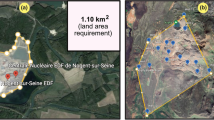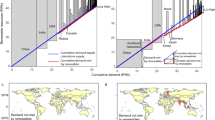Abstract
Cities are powerful political and economic entities, and for many cities cultivating renewable energy penetration is sound economic policy. Many power plants in the United States will need to be replaced in the coming decades, so opportunities for renewable energy development are imminent. Although numerous cities have committed to sourcing 100% of their electricity needs from renewables, those cities represent a very small portion of cities across the United States. Due to their high energy consumption, cities have environmental impacts in areas far from their centre but are often unaware of these impacts and are thus unmotivated to undergo a transition to more sustainable energy sources. Herein we present a spatial framework for matching the supply of energy to demand across the electricity grid that allows for allocation of city energysheds. A city energyshed comprises the network of power plants that supply a given city and the amount of energy drawn from each plant. The power plant–city links revealed by energysheds allow for estimations of a city’s energy mix and environmental footprint from electricity consumption, and provide urban areas with insights into their energy sources that can catalyse renewable energy penetration for cities seeking to expand their renewable portfolio.
This is a preview of subscription content, access via your institution
Access options
Access Nature and 54 other Nature Portfolio journals
Get Nature+, our best-value online-access subscription
$29.99 / 30 days
cancel any time
Subscribe to this journal
Receive 12 digital issues and online access to articles
$119.00 per year
only $9.92 per issue
Buy this article
- Purchase on Springer Link
- Instant access to full article PDF
Prices may be subject to local taxes which are calculated during checkout





Similar content being viewed by others
Data availability
The data that support the findings of this study are available from the corresponding author upon reasonable request.
References
Bakke, G. The Grid—The Fraying Wires Between Americans and Our Energy Future (Bloomsbury Publishing, 2016).
McManamay, R. A. et al. US cities can manage national hydrology and biodiversity using local infrastructure policy. Proc. Natl Acad. Sci. USA 114, 9581–9586 (2017).
Folke, C., Jansson, A., Larsson, J. & Costanze, R. Ecosystem appropriation of cities. Ambio 26, 167–172 (1997).
Tranos, E. & Gertner, D. Smart networked cities? Innovation Eur. J. Soc. Sci. Res. 25, 175–190 (2012).
Jin, J., Gubbi, J., Marusic, S. & Palaniswami, M. An information framework for creating a smart city through internet of things. IEEE Internet Things J. 1, 112–121 (2014).
Chen, T. Smart grids, smart cities need better networks. IEEE Netw. 24, 2–3 (2010).
Barber, B. R. Cool Cities: Urban Sovereignty and the Fix for Global Warming (Yale Univ. Press, 2017).
Pitt, D. & Bassett, E. Collaborative planning for clean energy initiatives in small to mid-sized cities. J. Am. Plann. Assoc. 79, 280–294 (2013).
Rueb, E. S. How New York City gets its electricity. New York Times (10 February 2017).
Ready for 100. Sierra Club (26 May 2017); https://www.sierraclub.org/ready-for-100
Cardwell, D. & Krauss, C. Coal country’s power plants are turning away from coal. New York Times (26 May 2017).
Amazon Amazon HQ2 Request for Proposal (2017); https://images-na.ssl-images-amazon.com/images/G/01/Anything/test/images/usa/RFP_3._V516043504_.pdf
America 2050: A Prospectus (Regional Plan Association, 2006).
Nelson, G. & Rae, E. An economic geography of the United States: from commutes to megaregions. PLoS ONE 11, e0166083 (2016).
Gui, E. M. & MacGill, I. Typology of future clean energy communities: an exploratory structure, opportunities and challenges. Energy Res. Soc. Sci. 35, 94–107 (2018).
Chmutina, K., Wiersma, B., Goodiera, C. & Devine-Wright, P. Concern or compliance? Drivers of urban decentralised energy initiatives. Sustain. Cities Soc. 10, 122–129 (2014).
von Meier, A. Electric Power Systems (Wiley, 2006).
Batty, M. The size, scale and shape of cities. Science 319, 769–771 (2008).
Tobler, W. R. A computer movie simulating urban growth in the Detroit region. Econ. Geogr. 46, 234–240 (1970).
Blume, S. W. Electric Power System Basics (Wiley, 2007).
Averyt, K. et al. Freshwater Use by US Power Plants: Electricity’s Thirst for a Precious Resource (Union of Concerned Scientists, 2011).
The North American Grid: Powering Cooperation on Clean Energy & the Environment (Canadian Electricity Association, 2016).
Greenhouse Gas Reporting Program https://www.epa.gov/ghgreporting/ghg-reporting-program-data-sets (EPA, 2010).
Hammer, S., Kamal-Chaoui, L., Robert, A. & Plouin, M. Cities and Green Growth: A Conceptual Framework (OECD Publishing, 2011).
Norman, J., MacLean, H. & Kennedy, C. Comparing high and low residential density: life-cycle analysis of energy use and greenhouse gas emissions. J. Urban Plan. D ASCE 132, 10–21 (2006).
ACEEE City Energy Efficiency Scorecard http://aceee.org/local-policy/city-scorecard (2016).
McKee, J. J., Rose, A. N., Bright, E. & Huynh, T. Locally adaptive, spatially explicit projection of US population for 2030 and 2050. Proc. Natl Acad. Sci USA 112, 1344–1349 (2015).
Kumar, A., Srivastava, S. & Singh, S. Congestion management in competitive power market: a bibliographical survey. Electric Power Syst. Res. 76, 153–164 (2005).
Shrestha, G. & Fonseka, P. Congestion-driven transmission expansion in competitive power markets. IEEE Trans. Power Syst. 19, 1658–1665 (2004).
Amin, S. & Wollenberg, B. Toward a smart grid: power delivery for the 21st century. IEEE Power Energy Mag. 3, 114–122 (2008).
Panteli, M. & Mancarella, P. The grid: stronger, bigger, smarter? IEEE Power Energy Mag. 13, 58–66 (2015).
Howe, P., Mildenberger, M., Marlon, J. & Leiserowitz, A. Geographic variation in opinions on climate change at state and local scales in the USA. Nat. Clim. Change 5, 596–603 (2015).
Wiersma, B. & Devine-Wright, P. Decentralising energy: comparing the drivers and influencers of projects led by public, private, community and third sector actors. Contemp. Soc. Sci. 9, 456–470 (2014).
Haarstad, H. Climate change, environmental governance and the scale problem. Geogr. Compass 8, 87–97 (2014).
National Electric Transmission Congestion Study (US Department of Energy, 2015).
US Installed and Potential Wind Power Capacity and Generation https://windexchange.energy.gov/maps-data/321 (2018).
Li, H. & Yi, H. Multilevel governance and deployment of solar PV panels in US cities. Energy Policy 69, 19–27 (2014).
Cheng, Q. & Yi, H. Complementarity and substitutability: a review of state level renewable energy policy instrument interactions. Renew. Sustainable Energy Rev. 67, 683–691 (2017).
Moodie, A. These 5 US towns are powered entirely by renewable energy Huffington Post (21 October 2017).
Uria-Martinez, R., Johnson, M. M. & O’Connor, P. W. 2017 Hydropower Market Report (Oak Ridge National Laboratory, 2018).
Painuly, J. Barriers to renewable energy penetration; a framework for analysis. Renew. Energy 24, 73–89 (2001).
Borenstein, S. & Bushnell, J. Electricity restructuring: deregulation or regulation. Cato Rev. Business Gov. 23, 46–52 (2000).
Deng, L., Hobbs, B. F. & Renson, P. In 37th IAEE International Conference Proceedings 45–47 (International Association for Energy Economics, 2014).
Platts Electric Power Maps and GIS Data https://www.spglobal.com/platts/en (2013).
Meehan, B. Modeling Electric Distribution with GIS (ESRI Press, 2013).
Form EIA-826 http://www.eia.gov/electricity/data/eia826/ (2010).
State of California Electricity Consumption by County http://ecdms.energy.ca.gov/elecbycounty.aspx (2010).
Hijmans, R., Cameron, S., Parra, J., Jones, P. & Jarvis, A. Very high resolution interpolated climate surfaces for global land areas. Int. J. Climatol. 25, 1965–1978 (2005).
Acknowledgements
This work was conducted by employees of UT-Battelle under contract no. DE-AC05-00OR22725 with the US Department of Energy. The authors thank B. Bhaduri, J. Neal, S. Wullschleger and J. Gulledge for support of the research concept, and J. Piburn and R. Stewart for assistance with residential energy demand estimates. Funding was provided by the Oak Ridge National Laboratory Directed Research and Development Program and by the US Department of Energy, Office of Science, Biological and Environmental Research, Integrated Assessment Program.
Author information
Authors and Affiliations
Contributions
C.R.D., R.A.M. and S.S.N. designed the research. C.R.D. and R.A.M. performed the research. C.R.D., R.A.M. and A.M.M. collected the data and performed the analysis. C.R.D. and R.A.M. wrote the paper.
Corresponding author
Ethics declarations
Competing interests
The authors declare no competing interests.
Additional information
Publisher’s note: Springer Nature remains neutral with regard to jurisdictional claims in published maps and institutional affiliations.
Supplementary information
Supplementary Information
Supplementary Figs. 1–10
Supplementary Information
Supplementary Tables
Rights and permissions
About this article
Cite this article
DeRolph, C.R., McManamay, R.A., Morton, A.M. et al. City energysheds and renewable energy in the United States. Nat Sustain 2, 412–420 (2019). https://doi.org/10.1038/s41893-019-0271-9
Received:
Accepted:
Published:
Issue Date:
DOI: https://doi.org/10.1038/s41893-019-0271-9
This article is cited by
-
Governing sustainable transformations of urban social-ecological-technological systems
npj Urban Sustainability (2022)
-
Decarbonization, population disruption and resource inventories in the global energy transition
Nature Communications (2022)
-
U.S. national water and energy land dataset for integrated multisector dynamics research
Scientific Data (2022)
-
Selective extraction of uranium from seawater with biofouling-resistant polymeric peptide
Nature Sustainability (2021)



